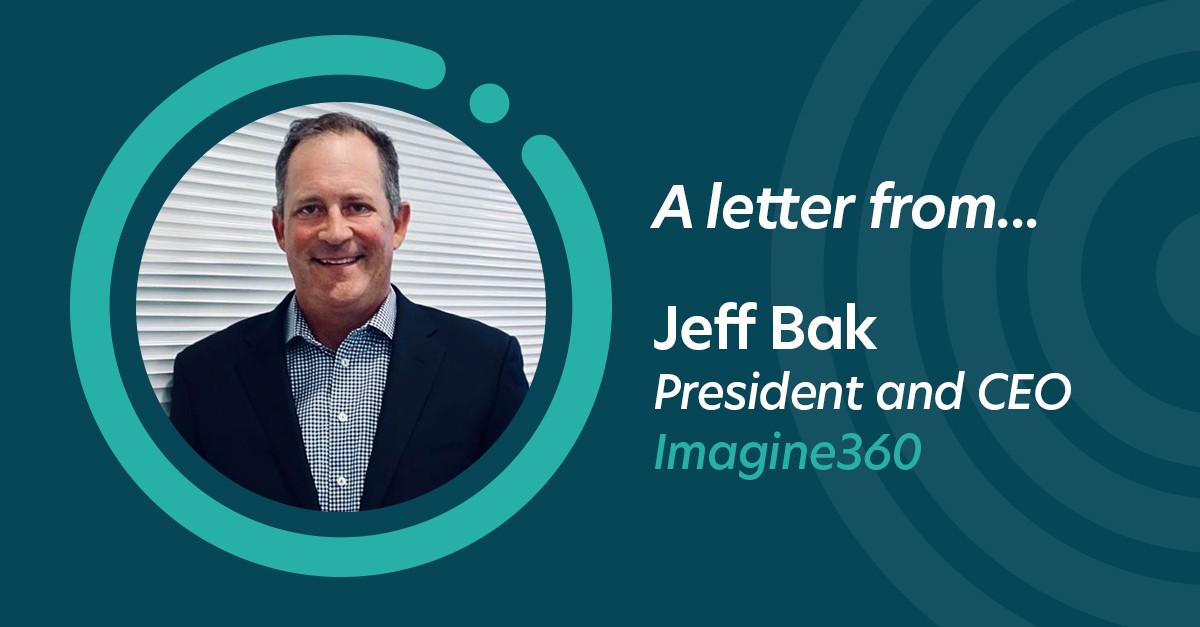Imagine360 CEO, Jeff Bak, was featured in an article for CFO Dive, where he spoke about the importance of collaboration between CFOs and HR leaders when building a robust and cost-effective employer health plan strategy.
To find a healthcare sweet spot, CFOs and HR leaders must “give a little each,” Imagine360’s Jeff Bak said.
Healthcare ranks among an organization’s top costs, typically second only to that of labor. Persistent inflation and lingering effects from the COVID-19 pandemic have further pushed up expenses in this area, with health benefit costs for North America rising by 9.8% this year, CFO Dive previously reported.
For finance chiefs tasked with lowering costs, in order to optimize their healthcare spending, “the CFO has to partner with the head of HR or the head of benefits, and they collectively have to get on the same page,” said Jeff Bak, president and CEO of full-service health plan provider Imagine360. An alum of the healthcare industry, Bak has served in the top executive seat for the Wayne, Pennsylvania-based company for four years, according to his LinkedIn profile.
Imagine360 offers reference-based pricing to self-funded businesses, which allows employers — coupled with the support of a third-party vendor — to pay a set price for the health care services they offer their employees rather than negotiate with providers, according to the American Hospital Association.
Finding the healthcare sweet spot
With benefit costs jumping, CFOs are put into the difficult position of trying to reduce those costs while also ensuring their employees are satisfied and have access to the plans they need. Providing a robust healthcare plan is a critical piece of employee retention for many firms, CFO Dive previously reported.
Many employers also stated plans earlier in the year to augment their health care plans with benefits, including telehealth and mental health services over the next two years, CFO Dive previously reported. The crucial task for CFOs, therefore, is to balance affordability with the cost of care, which is increasingly difficult as finance chiefs run out of potential levers to pull, Bak said.
“When you really think about it at the macro level, you’ve got to figure out a way to lower your unit costs or what you’re paying providers,” he said. “And there aren’t many ways to do that, other than either limiting the selection, or a narrow kind of relationship where they’re going to get the bulk of your employees utilization.”
For example, with larger players in the healthcare space, employers are heavily reliant on their PPO networks — which provide their employees with freedom of choice, but are not ideal for cost optimization because “there’s so much variability in those networks and one geography” where employers can pay three or four times more for services without realizing, Bak said.
To find a sweet spot where companies can reduce the cost of care, but still offer as robust a healthcare plan as possible, both the CFO and HR leaders need to work together; having open communication between these two leaders is a crucial part of getting together a satisfactory health plan for everyone involved, “because one can override the other one,” Bak said. “One can say, ‘I don’t want any disruption and no change,’ and the other one says, ‘all I want is to save.’”
For its part, Imagine360 has the best chances of connecting with a client and making a sale when the CFO and top HR leader get to a point where “they give a little each,” Bak said, compromising where “they can save some money and then they can reach out to the population and say, ’you’re going to save, we’re going to save, here’s how we’re going to give it back to you guys.”
Reinvesting into healthcare
Since health care plans are usually established on a cyclical basis once a year, most companies are stuck with the upcoming costs for next year, where they are seeing higher renewal rates than anticipated — a source of significant frustration for many businesses, Bak said.
As firms begin planning for 2025, many are asking for comprehensive plans for their broker or shopping around for new potential vendors because “we’re not going to get stuck in the cycle again, where we don’t have enough time because we can make economic decisions,” Bak said of companies.
When it comes to actionable areas where CFOs can save on rising healthcare costs, it’s “not out of the question” that finance chiefs may be able to save somewhere between $2,000 to $3,000 annually per employee with a move into dual options, Bak said.
This means that the company keeps its PPO network, but “you also use something like narrow network or direct contract or reference-based pricing and you bolster that with kind of a concierge team to help with steerage and plan navigation,” he said.
Such a move represents significant one-time savings and should show up within the first year, he said. Lower inflation pressures associated with such options can also help to alleviate some of the financial pressures CFOs and HR leaders face — which could then free up funds that enable those leaders to take another look at other health care offerings such as prescription benefit costs or special pharmacy benefits, for example, Bak said.
Reinvesting savings into one’s health care plan can also have greater benefits for an organization; finding ways to reduce employee contributions can help with retention, for example, saving businesses funds in other ways.
“It also helps with recruitment because they have a bit of a richer plan now than they did, with a few caveats in terms of who they can go to and where they can go,” Bak said.


